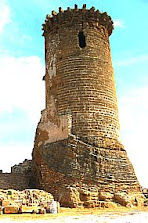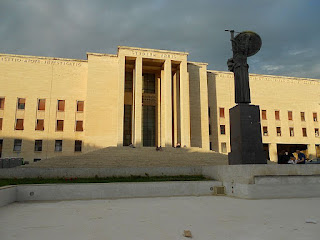The ‘great patriot’ was of Albanian heritage
The death at the age of 82 in Naples of the Italian statesman Francesco Crispi, who was a key figure during the Risorgimento, was announced on this day in 1901..jpg)
A photographic portrait from the
1880s of Francesco Crispi
He was a close friend of Giuseppe Mazzini and Giuseppe Garibaldi, and it was Crispi who persuaded Garibaldi to invade Sicily in 1860 with his band of volunteers known as The Thousand. Quickly conquering Sicily, Garibaldi proclaimed himself dictator and named Crispi as Minister of the Interior.
Crispi was born in Ribera in Sicily in 1818. His father’s family were originally from Palazzo Adriano in south western Sicily, which had been founded by Orthodox Christian Albanians. Crispi was brought up to speak Italian, along with Greek, Albanian and Sicilian.
By the time he was 11, Crispi was attending a seminary in Palermo. He then studied law and literature at the University of Palermo, receiving a law degree in 1837.
Crispi founded his own newspaper, L’Oreteo, which brought him into contact with political figures. He wrote about the need to educate poor people, the damage caused by the wealth of the Catholic Church and the need for all citizens, including women, to be considered equal.
In 1845 he became a judge in Naples, where he became well known for his liberal and revolutionary ideas.
Crispi travelled to Palermo in 1847 to prepare for the revolution against the Bourbon monarchy in Sicily. Afterwards, he was appointed a member of the provisional Sicilian parliament and supported the separatist movement that wanted to break ties with Naples. But when the Bourbons took back control of Sicily by force in 1849, Crispi was forced to flee the island.
 |
| The uprising against the Bourbons in Sicily in 1848, which Crispi and others encouraged |
From there he went to London, where he became a revolutionary conspirator and was involved in the Italian national movement.
After returning to Italy, Crispi travelled round Sicily in disguise, preparing for the conquering of the Kingdom of the Two Sicilies.
Crispi was appointed first secretary of state in the provisional government, where he found himself in opposition to Cavour, the prime minister of the Kingdom of Sardinia, who wanted to annex Sicily to Piedmont.
In the general election of 1861, before the establishment of the Kingdom of Italy, Crispi was elected a member of the Historical Left for the constituency of Castelvetrano, a seat he would hold for the rest of his life.
Crispi acquired the reputation for being aggressive and earned the nickname of Il Solitario, the Loner. In 1864 he deserted Mazzini and announced he was a monarchist. He told Mazzini in a letter: ‘The monarchy unites us, the republic would divide us.’ On the outbreak of the Franco-Prussian war, he worked to impede a projected alliance with France.
.jpeg) |
| The assassination attempt that Crispi survived in 1894 |
In 1881, Crispi was one of the main supporters of universal male suffrage and in 1887 he was appointed by the King as Prime Minister and Minister of Foreign Affairs. He abolished the death penalty, revoked anti strike laws, limited police powers, and reformed the penal code.
His government lost its majority after his Minister of Finance had to reveal a higher than planned deficit and Crispi resigned in 1891. He was asked to form a new government in 1893 and the following year had to declare a state of siege throughout Sicily.
In 1894, an anarchist tried to shoot Crispi but failed. Crispi introduced a series of anti-anarchist laws that strengthened his position.
During his second term, Crispi continued colonial expansion in East Africa, which led to the first Italo-Ethiopian war.
An attempt was made to prosecute Crispi for embezzlement, but a parliamentary commission refused to authorise it. He resigned his seat in parliament, but was re-elected in 1898 by his Palermo constituents.
After his health declined, Crispi died in Naples on the evening of Sunday, August 11, 1901, with his death announced the following morning. He is remembered as a colourful, patriotic politician. His fiery nature and turbulent personal and political life have been ascribed to his Albanian heritage. He was once saluted by Giuseppe Verdi as ‘the great patriot’ and streets in Italy are still named after him to this day.
Travel tip:
One of the towers at
Castello di Poggio Diana
Ribera, the birthplace of Francesco Crispi, is a town of almost 18,000 inhabitants situated about 50km (31 miles) from Agrigento on the southwest flank of the island of Sicily. Sometimes known as "the city of oranges" it sits on the Plain of San Nicola, between the valleys of the Verdura and Magazzolo rivers. The town's main sights include the 18th century Chiesa Madre, which remained closed for more than 30 years following an earthquake in 1968 but has been restored. Outside the town, on a gorge overlooking the Verdura river, is the Castello di Poggio Diana, built by Guglielmo Peralta in the 14th century. Agriculture is the town's main industry, involving the cultivation and marketing of the Washington navel orange - introduced by emigrants returned from the United States - and strawberries.
Travel tip:.jpg)
The Via Francesco Crispi is in the heart of
Rome's historic city centre
Many streets in Italy take the name of Francesco Crispi. The Via Francesco Crispi in Rome bisects the historical centre of the city between Piazza di Spagna and Piazza Barberini, a few minutes' walk away from the Villa Borghese, Piazza del Popolo and the Trevi Fountain. The Volpetti family's gourmet food business, established in 1870, is located on Via Francesco Crispi, as is the historic Crispi 19 restaurant, opened in 1873, and the upmarket Marini shoe shop. The street is also home to the Galleria Comunale d'Arte Moderna, a former16th-century monastery now turned museum housing a large collection of works by late 19th and early 20th century artists including Giacomo Balla, Carlo Carrà, Arturo Dazzi, Giorgio de Chirico, Renato Guttuso, Giacomo Manzù and Giorgio Morandi.
Also on this day:
1612: The death of Venetian composer Giovanni Gabrieli
1861: The birth of anarchist Luigi Galleani
1943: The death of mountaineer and photographer Vittorio Sella
1990: The birth of football Mario Balotelli

%20(2).png)

.jpg)

%20(2).jpg)

.jpg)


.jpg)
.jpg)

.jpg)

.jpg)
.jpg)


.jpg)
.jpg)



_scena_.jpg)

.jpg)
